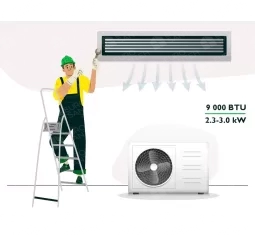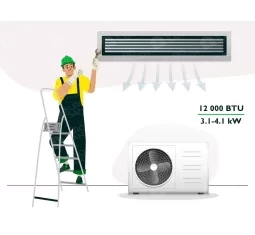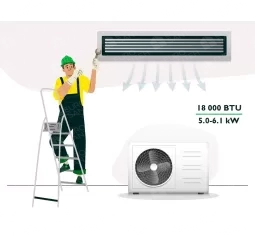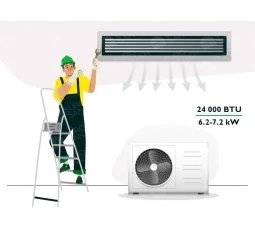Air conditioner installation on a rooftop in Chisinau
Installing an air conditioner on a rooftop presents a series of unique challenges and considerations that require careful planning and execution to ensure optimal performance and safety. Rooftop installations are common in urban environments where space is limited or in commercial buildings seeking efficient cooling solutions. In this text, we will explore the process, key considerations, and benefits of installing an air conditioner on a rooftop.
Key Considerations
Structural Assessment: The first step in installing an air conditioner on a rooftop is conducting a thorough structural assessment. Engineers evaluate the rooftop's load-bearing capacity, structural integrity, and any reinforcement needs to support the weight of the air conditioning unit and ensure it can withstand environmental factors like wind and seismic activity.
Location Selection: Choosing the right location on the rooftop is critical for optimal functionality and efficiency. Factors such as sun exposure, accessibility for maintenance, proximity to electrical connections, and minimizing noise impact on building occupants are all taken into account during this phase.
Electrical and Plumbing Considerations: Planning the routing of electrical wiring and refrigerant lines from the rooftop unit to the indoor units is crucial. Proper insulation and protection against weather elements ensure the longevity and efficiency of the system.
Weatherproofing and Safety Measures: Rooftop installations require robust weatherproofing to protect the equipment from rain, snow, and UV exposure. Safety measures, including secure anchoring of the unit, guardrails or barriers around the installation area, and access points for maintenance personnel, are also essential.
Installation Process
The installation process of an air conditioner on a rooftop typically follows these steps:
Preparation and Planning: Detailed planning involves site surveys, obtaining necessary permits, and coordinating with structural engineers and HVAC professionals to ensure compliance with building codes and safety standards.
Mounting the Outdoor Unit: The outdoor unit, which includes compressors and condensers, is securely mounted on the rooftop using specialized mounts or frames designed to withstand rooftop conditions.
Connecting Refrigerant Lines and Electrical Wiring: Refrigerant lines and electrical cables are carefully routed from the outdoor unit to the indoor units located inside the building. This step requires precise measurements and sealing to prevent leaks and ensure efficient operation.
Installing Indoor Units: Indoor units, such as wall-mounted or ceiling-mounted air handlers, are installed inside the building according to the layout and cooling requirements of each room or area.
Testing and Commissioning: After installation, the entire system is tested to ensure proper operation. This includes checking refrigerant levels, testing airflow and temperature control, and verifying that all components function correctly.
Benefits of Rooftop Installations
Space Efficiency: Rooftop installations maximize usable space on the ground level for other purposes, such as parking or outdoor areas.
Reduced Noise: Placing the air conditioner on the rooftop helps minimize noise inside the building, enhancing comfort for occupants.
Improved Air Circulation: Rooftop installations benefit from better airflow and ventilation, contributing to more efficient cooling and energy savings.
Aesthetic Considerations: Rooftop installations can be designed to blend with the building's architecture, maintaining aesthetic appeal while providing functional cooling solutions.
Environmental Considerations
Energy Efficiency: Choosing energy-efficient air conditioning units reduces electricity consumption and operational costs over time.
Sustainable Practices: Rooftop installations can incorporate green building practices, such as using solar-powered units or integrating with building management systems for optimal energy use.
Maintenance and Longevity
Regular maintenance is crucial for rooftop air conditioning units to ensure longevity and optimal performance. This includes cleaning filters, inspecting refrigerant levels, and scheduling periodic tune-ups to address any potential issues before they escalate.
Conclusion
Installing an air conditioner on a rooftop requires careful planning, expertise in structural engineering and HVAC systems, and adherence to safety and environmental standards. By considering key factors such as structural integrity, location selection, and efficient system design, rooftop installations can provide reliable cooling solutions for residential and commercial buildings alike. Consulting with experienced HVAC professionals ensures that the installation process is seamless and meets the specific cooling needs of the building while maximizing energy efficiency and occupant comfort.
















